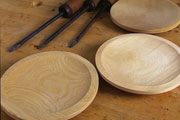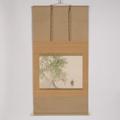Miyagi and more
- Sort by
- Popularity
- Name
-
Edo kiriko cut glass Edo kiriko
- Other crafts
- Tokyo

Edo kiriko is the most famous glass craftwork in Japan. It was originally produced in the city of Edo which was Tokyo's name during the Edo period (1603-1868). Kiriko means "cut glass" so its name means "cut glass from the city…
View more
-
Kamakura-bori lacquerware Kamakura bori
- Lacquerware
- Kanagawa

Kamakura-bori is a type of lacquer ware made in the area around the city of Kamakura in Kanagawa prefecture. The tradition dates back to the Kamakura period (1185-1333) when Tsuishu and Tsuikoku, thickly lacquered wooden wares, were imported from …
View more
-
Hakone wood mosaic Hakone yosegi zaiku
- Wood, bamboo crafts
- Kanagawa

Hakone yosegi zaiku is a form of marquetry produced in the town of Hakone, Kanagawa prefecture, an area renowned for having the most natural environment in Japan. For this reason, there is a rich variety of tree species found on Mt. Hakone. Such a…
View more
-
Kiso lacquerware Kiso shikki
- Lacquerware
- Nagano

Kiso lacquerware (called Kiso shikki in Japanese) is produced in Kiso district, now the city of Shiojiri, Nagano prefecture. The area where this craft is produced is a plateau approximately 900 meters above sea level. The climate has cool summers…
View more
-
Matsumoto furniture Matsumoto kagu
- Wood, bamboo crafts
- Nagano

Matsumoto kagu is a type of Japanese traditional furniture made in the city of Matsumoto in Nagano prefecture and has been produced for over three hundred years, since the Edo period (1603-1868). The Second World War led production of this craft t…
View more
-
Ogatsu inkstone Ogatsu suzuri
- Writing tools
- Miyagi

Ogatsu inkstone (called Ogatsu suzuri in Japanese) is a craft produced in the former town of Ogatsu (now city of Ishinomaki), Miyagi prefecture, where artisans still carefully hand carve and polish every piece. What is unique to Ogatsu inkstone i…
View more
-
Beppu bamboo crafts Beppu take zaiku
- Wood, bamboo crafts
- Oita

Beppu take-zaiku are bamboo crafts produced in the city of Beppu, Oita prefecture mainly from odake bamboo* grown and harvested locally. This craft is entirely handmade and uses a distinctive range of basic weaving techniques. It is also the only …
View more
-
Edo wood joinery Edo sashimono
- Wood, bamboo crafts
- Tokyo

Edo sashimono is a type of wood joinery made in Tokyo with hand-cut dovetail joints and without nails. The word sashimono comes from the process of measuring with a monosashi or woodwork ruler. This craft is characterized by its restrained ornamen…
View more
-
Edo glass Edo garasu
- Other crafts
- Tokyo

Edo glassware is crafted in the Edogawa, Sumida, and Koto wards of Tokyo. It is also now produced in some areas of nearby Chiba prefecture, but it has been recognized as a local industry of Tokyo. This craftwork uses manufacturing methods, materia…
View more
-
Murayama-oshima tsumugi silk Murayama oshima tsumugi
- Woven textiles
- Tokyo

Murayama oshima tsumugi is a silk textile produced in the region surrounding Musashi murayama in western Tokyo. This craft is produced from hand-spun threads pulled from dupioni silk and has kasuri patterns* woven with both warp and weft patterns.…
View more
-
Nara brushes Nara fude
- Writing tools
- Nara

Nara brushes (called Nara fude in Japanese) are brushes produced in and around the neighboring cities of Nara and Yamatokoriyama, Nara prefecture. Nara is considered to be the birthplace of brush making in Japan. The oldest existing brushes in Jap…
View more
-
Tokyo silverware Tokyo ginki
- Metal works
- Tokyo

Tokyo silverware (called Tokyo ginki in Japanese) is a form of metal handicraft produced mainly in different wards of Tokyo like Taito, Arakawa, and Bunkyo. It is a traditional craft that has been passed down from the Edo period (1603-1868), and e…
View more
-
Edo patterned paper Edo karakami
- Other crafts
- Tokyo

Edo karakami is a type of decorated traditional paper produced in the Bunkyo and Taito wards of Tokyo, as well as Matsudo, Chiba prefecture, and Tokigawa, Saitama prefecture. Designated as a traditional craft by the Japanese government in May 1999…
View more
-
Tokyo fine-patterned dyeing Tokyo some komon
- Dyed textiles
- Tokyo

Tokyo fine-patterned dyeing (called Tokyo some komon in Japanese) is a stencil dyed textile produced in different wards of Tokyo like Shinjuku and Setagaya. It was designated as a traditional national craft in 1976. This textile can seem plain fro…
View more
-
Edo bamboo fishing rods Edo wazao
- Wood, bamboo crafts
- Tokyo

Edo wazao are fishing rods that are produced in the Kanto region, mainly Tokyo and the prefectures of Chiba and Saitama. This craft is named after the Edo lineage of the craftsmen and not the production area of Edo (now Tokyo). It is made from sev…
View more
-
Odawara lacquerware Odawara shikki
- Lacquerware
- Kanagawa

Odawara lacquerware (called Odawara shikki in Japanese) is a type of lacquerware that is made in the city of Odawara, Kanagawa prefecture. It features a glossy lacquer finish which highlights the elegant grain of the wood material. While beautiful…
View more
-
Naruko lacquerware Naruko shikki
- Lacquerware
- Miyagi

Naruko lacquerware (called Naruko shikki in Japanese) is a form of lacquerware produced around the city of Osaki, Miyagi prefecture. Lacquerware is a craft coating layers of lacquer on wooden tableware and other utensils. Lacquerware is produced i…
View more
-
Shinshu tsumugi silk Shinshu tsumugi
- Woven textiles
- Nagano

Shinshu tsumugi is a type of silk fabric also known as pongee and produced throughout Nagano prefecture. Each region in the prefecture has their own production styles and techniques. Also, the specific name of this fabric differs depending on the …
View more
-
Tama brocade Tama ori
- Woven textiles
- Tokyo

Tama brocade (called Tama ori in Japanese) is a woven silk fabric produced around Hachioji, Tokyo. Since ancient times, Tama ori has been well-known under the name of Hachioji woven fabric. The following five different types of woven fabric are …
View more
-
Iiyama Buddhist altar Iiyama butsudan
- Household Buddhist altars
- Nagano

Iiyama Buddhist Altars, called Iiyama Butsudan in Japanese, are made around the city of Iiyama, Nagano prefecture. Iiyama is known for its people being devout to Buddhism since ancient times, which sustains the tradition of altar production. This …
View more
-
Miyagi kokeshi doll Miyagi dento kokeshi
- Dolls, kokeshi
- Miyagi

Miyagi Kokeshi Dolls (called Miyagi Dento Kokeshi in Japanese) are wooden dolls produced in and around the cities of Sendai and Shiraishi, Miyagi prefecture. Categorized based on region into five styles including Naruko kokeshi and Togatta kokeshi…
View more
-
Uchiyama Japanese paper Uchiyama gami
- Traditional Japanese paper
- Nagano

Uchiyama Gami is a type of traditional Japanese paper made in the Oku-shinano region of northern Nagano prefecture. As a region that gets heavy snowfall during the winter, papermaking production developed to provide supplementary income. This craf…
View more
-
Hachio island silk Honba kihachijo
- Woven textiles
- Tokyo

Honba Island Silk (called Honba Kihachijo in Japanese) is produced on Hachijojima Island in Tokyo. The name of this craft derives from a silk fabric with stripe and check patterns mainly dyed in bright yellow called kihachi. Patterns mainly dyed i…
View more
-
Shinshu Forged Blades Shinshu uchihamono
- Metal works
- Nagano

Shinshu Forged Blades or Shinshu Uchihamono in Japanese, are metalworks produced around Nagano, Nagano prefecture. As this area was formerly a province called Shinano which was also called Shinshu, these blades are known under the name of "Sh…
View more
-
Takayama tea whisks Takayama chasen
- Wood, bamboo crafts
- Nara

Takayama Tea Whisks, called Takayama Chasen in Japanese, are tea whisks produced in Takayama Town, Ikoma City, Nara Prefecture. Each tea whisk is completely made by hand and they have a top class share in the total Japanese tea whisk market. The t…
View more
-
Woodblock prints Edo mokuhanga
- Other crafts
- Tokyo

Techniques for woodblock prints were developed and refined during the Edo period (1603-1868), and Edo Woodblock Prints called Edo Mokuhanga in Japanese, contributed to spreading beautiful printed art forms such as ukiyoe (a genre of Japanese art).…
View more
-
Nagiso woodturning Nagiso rokuro zaiku
- Wood, bamboo crafts
- Nagano

Nagiso Rokuro Zaiku are completely handmade woodwork items made in the area around Nagiso Town, Kiso-gun, Nagano Prefecture. This traditional craft originated in the first half of the 18th century and is known for a special skilled manufacturing c…
View more
-
Tokyo textiles Tokyo tegaki yuzen
- Dyed textiles
- Tokyo

Tokyo Tegaki Yuzen are kimono textiles produced in Shinjuku Ward, Nerima Ward and Nakano Ward, Tokyo. Having been produced in the townsmen culture of Edo (current Tokyo), a refined stylishness is expressed in its soft, subdued colors. Unlike other…
View more
-
Edo-sekku doll Edo sekku ningyo
- Dolls, kokeshi
- Tokyo

Edo Sekku Ningyo are dolls produced in 12 of the wards in Tokyo and four cities in Saitama Prefecture. They are costumed dolls, such as ichimatsu ningyo (play dolls), gosho ningyo (palace dolls) and fuzoku ningyo (dolls in period costumes), as wel…
View more
-
Edo Hyogu (Art Mountings) Edo Hyogu
- Other crafts
- Tokyo

Hyougu (art mountings) are used to set up calligraphic works and paintings into hanging scrolls, picture frames, and folding screens etc. for display and preservation. There are various types of art mountings such as hanging scrolls and scrolls, f…
View more































































































































































































































































































